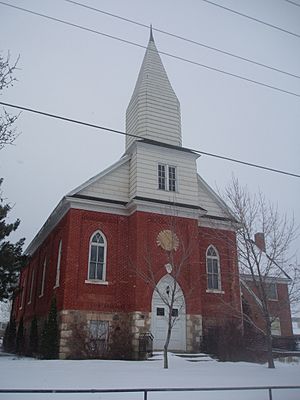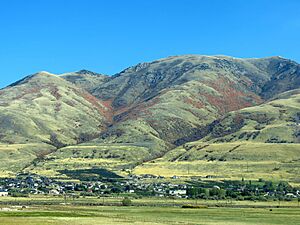Perry, Utah facts for kids
Quick facts for kids
Perry, Utah
|
|
|---|---|

The Heritage Community Theatre, a Perry landmark
|
|
| Motto(s):
"Building a Community Together"
|
|

Location in Box Elder County and the state of Utah
|
|

Location of Utah in the United States
|
|
| Country | United States |
| State | Utah |
| County | Box Elder |
| Settled | 1853 |
| Named for | Gustavus Adolphus Perry |
| Area | |
| • Total | 8.00 sq mi (20.72 km2) |
| • Land | 8.00 sq mi (20.72 km2) |
| • Water | 0.00 sq mi (0.01 km2) |
| Elevation | 4,301 ft (1,311 m) |
| Population
(2010)
|
|
| • Total | 4,512 |
| • Estimate
(2019)
|
5,248 |
| • Density | 656.08/sq mi (253.32/km2) |
| Time zone | UTC-7 (Mountain (MST)) |
| • Summer (DST) | UTC-6 (MDT) |
| ZIP code |
84302
|
| Area code(s) | 435 |
| FIPS code | 49-59390 |
| GNIS feature ID | 2411405 |
Perry is a city located in Box Elder County, Utah, in the United States. It's a friendly place with a population of about 4,500 people, according to the 2010 census. Perry is known for its beautiful views and a mix of quiet neighborhoods and open spaces.
Contents
What is the History of Perry?
Early Settlers and Names
The land where Perry now stands was first claimed in 1851 by brothers Orrin Porter Rockwell and Merritt Rockwell. However, they didn't build homes there. The first permanent settlers, who were LDS pioneers, arrived in 1853. William Plummer Tippets built a cabin at a spot called "Three Mile Creek." This name came from a creek located three miles south of what is now Brigham City.
Another nearby settlement was known as "Welsh Settlement." In 1869, Welsh Settlement joined with Three Mile Creek. Later, in 1898, the community was renamed Perry. It was named after Gustavus Adolphus Perry and his family, who were important early settlers in the area.
Church History in Perry
In 1854, Gustavus Adolphus Perry became the leader of the local LDS branch. A branch is a small group of church members. The area had different branch leaders until 1877. That year, it became a larger group called a ward, with Orrin Alonzo Perry as its bishop.
By 1930, Perry had 341 residents, and they still had only one ward. In 2008, a new larger church group, called the Perry Utah Stake, was created. This stake includes nine wards, showing how much the community has grown.
Floods in Perry
Perry has experienced floods in its history. In June 1896, a reservoir that wasn't fully built yet overflowed. This caused a big flood in the town, damaging homes and covering farms with mud and rocks. Another flood happened in 1923, but it caused less damage than the first one.
Where is Perry Located?

Perry is located in the southeastern part of Box Elder County. It shares its northern border with Brigham City and its southern border with Willard. To the east, the city is next to the Cache National Forest and the northern part of the Wasatch Range, which are mountains.
Roads and Transportation
Major highways like I-15 and I-84 pass through the western side of Perry. You can get to Perry from these highways using Exit 357 (south of the city in Willard) or Exit 362 (north of the city through Brigham City). U.S. Route 89 runs right through the middle of the city.
What is Perry Like Today?
Historically, Perry was mostly a rural and farming community. There were many family dairies, cattle farms, and fruit orchards. You could find many fruit stands along U.S. 89, which is part of what's known as Utah's Fruit Belt. This area stretches all the way to southern Idaho.
Today, Perry is mainly a suburban residential community. This means many people live there and commute to work in other areas. There are some businesses along the northern border with Brigham City and along U.S. 89.
The United States Census Bureau states that Perry covers about 8 square miles (20.8 square kilometers) of land.
What is the Population of Perry?
| Historical population | |||
|---|---|---|---|
| Census | Pop. | %± | |
| 1900 | 260 | — | |
| 1910 | 292 | 12.3% | |
| 1920 | 367 | 25.7% | |
| 1930 | 341 | −7.1% | |
| 1940 | 383 | 12.3% | |
| 1950 | 449 | 17.2% | |
| 1960 | 587 | 30.7% | |
| 1970 | 909 | 54.9% | |
| 1980 | 1,084 | 19.3% | |
| 1990 | 1,211 | 11.7% | |
| 2000 | 2,383 | 96.8% | |
| 2010 | 4,512 | 89.3% | |
| 2020 | 5,555 | 23.1% | |
| U.S. Decennial Census | |||
As of the 2010 census, there were 4,512 people living in Perry. The city had 1,373 households, and 1,179 of these were families. The population density was about 564 people per square mile. There were 1,427 housing units in total.
Diversity in Perry
The racial makeup of the city in 2010 was mostly White (94.5%). Other groups included African American (0.1%), Native American (0.7%), Asian (0.7%), and Pacific Islander (0.3%). About 1.8% of the population was from other races, and 1.8% identified as being from two or more races. People of Hispanic or Latino background made up 4.6% of the population.
Households and Families
Out of the 1,373 households, 46.5% had children under 18 living with them. Most households (76.3%) were married couples living together. About 6.9% of households had a female head with no husband present. Around 14.1% were non-family households.
About 12.0% of all households were made up of individuals living alone. Of these, 5.3% had someone aged 65 or older living by themselves. The average household size was 3.29 people, and the average family size was 3.60 people.
Age Distribution
The population in Perry was spread out across different age groups. About 36.1% of residents were under 18 years old. Those aged 18 to 24 made up 6.5%, while 27.2% were between 25 and 44. People aged 45 to 64 accounted for 19.1%, and 11.1% were 65 years or older. The average age in the city was 31.1 years.
What Schools are in Perry?
Perry is part of the Box Elder School District. The city has two elementary schools:
- Three Mile Creek Elementary
- Promontory School of Expeditionary Learning (a public charter school)
Students who are in higher grades attend schools in nearby Willard and Brigham City.
What Can You Do for Fun in Perry?
Perry has several places for recreation and outdoor activities.
- The city has four parks. One park has a baseball diamond and space for soccer. Another park has two soccer fields. There is also a nature park.
- You can find trails for hiking that go up the canyons into the Cache National Forest. These trails also connect with the Bonneville Shoreline Trail, which offers beautiful views.
See also
 In Spanish: Perry (Utah) para niños
In Spanish: Perry (Utah) para niños

